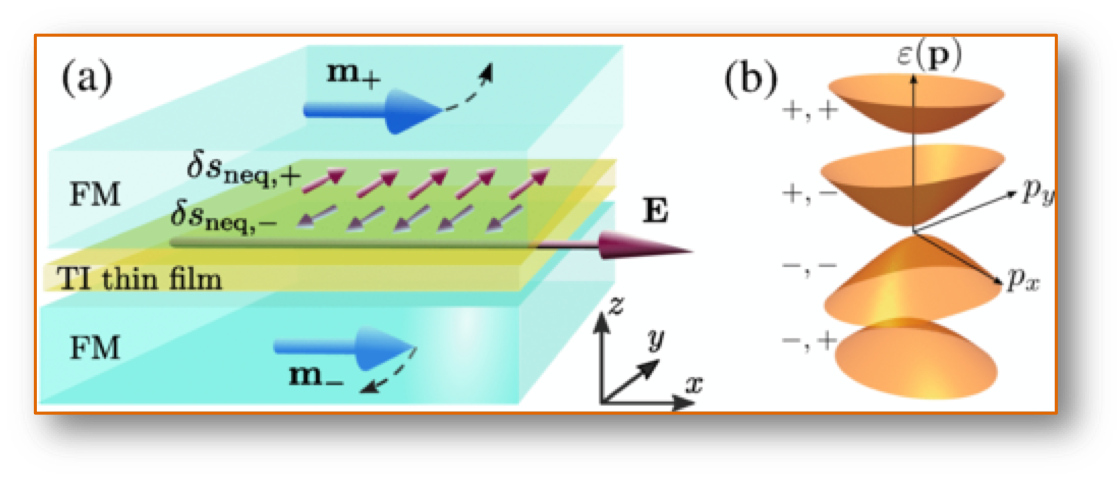
Project Description
PROJECT AIMS:
The aim of this project is the need of explaining the physical origins of the new kind of magnetoresistance phenomenon measured experimentally very recently at the surface of topological insulators (TIs) and oxides interfaces that reveals linear response to both electric and magnetic field simultaneously. This so-called bilinear magnetoresistance (BMR) emerging in the systems with a strong spin-orbit coupling (SOC) is a manifestation of higher order responses as well as specific properties of the systems that come from symmetry. The non-linear (with respect of electric field) effects assisted by the spin-orbit interaction need a consistent theoretical formulation, that should take into account all possible origins (both intrinsic and extrinsic) of such system response. This unidirectional/ bilinear magnetoresistance is the tip of the iceberg of a more fundamental issue, that is, the nonreciprocal response of quantum systems with broken inversion symmetry. Therefore, the theoretical studies, proposed in this project, have as its objective two general goals:
- Investigation of the fundamental aspects of nonreciprocal and nonlinear transport phenomena induced by spin-orbit coupling in selected systems described by certain effective Hamiltonians of specific symmetries.
- Indication of efficient ways of measurement and possible application of the spin-to-charge inter-conversion phenomena .
Within the project, both analytical and advanced numerical methods will be used. The electron and spin transport calculations will be done both semi-classically and quantum-mechanically since one of the project tasks also assumes formal studies aimed at clarifying possible differences between these two approaches (and possible failings of semi-classical description). Thus, analytical calculations will be done based on zero-temperature and Matsubara Green’s function formalism as well as Keldysh-approach (Kadanoff-Baym equations). The ab-initio calculations that will concern modeling of band structure, magnetism, and possible transport through van-der-Waals hybrid structures will be performed.
PROJECT TASKS:
The main objectives might be divided by the four tasks: TASK 1: Theoretical description of BMR in selected 2D systems: surface states of TI, graphene-like 2D crystals and van-der-Waals heterostructures, 2D gas at the interfaces of semiconductor heterostructures and oxides perovskites. TASK 2: Theoretical description of spin-orbit driven phenomena beyond linear-response limit. TASK 3: Identification of the possible origins of negative magnetoresistance in systems with spin-orbit interaction beyond the weak localization regime. TASK 4: Investigation of electronic and spin transport through two-dimensional layered systems and interfaces.
IMPORTANCE OF THE PROJECT:
Understanding the physical origins responsible for BMR and other unidirectional effects allow for their application in new electronics devices. In principle, one can think about the new kind of the read-write protocols in the hard drives and logic devices, where the “0” and “1” states related with high and low resistance state of the electronic element can be provided by the two opposite current flow directions. Moreover, BMR gives a real chance for electrical mapping the spin texture of the topological surface states. This, in turn, would be a great alternative to the angle-resolved photoemission spectroscopy (ARPES). The theoretical studies assumed in this project concern fundamental issues of condensed matter physics such as the role of symmetries and topology of electronic states in low-dimensional systems. Moreover, results obtained in the project should provide a better understanding of the spin-to-charge interconversion effects. This group of phenomena are extensively studied in last years and seem to be very promising for the application in the new generation of spintronics devices.
Realization period: 02.09.2019 - 02.09.2022
Project Team:
Faculty of Physics, Adam Mickiewicz University in Poznan
Dr. Anna Dyrdał (PI)
Kateryna Boboshko (PhD student)
Rzeszow University of Technology
Prof. Vitalii Dugaev (mentor)
Sylwia Kudla
Publications
Articles:
Longitudinal magnetoresistance in graphene with random Rashba spin-orbit interaction
Phys. Rev. B 111, 075413 (2025)
Localized states at the Rashba spin-orbit domain wall in magnetized graphene: Interplay of Rashba and magnetic domain walls
Phys. Rev. B 109, 134435 (2024)
Bilinear magnetoresistance and planar Hall effect in topological insulators: Interplay of scattering on spin-orbital impurities and nonequilibrium spin polarization
Phys. Rev. B 109, 155420 (2024)
Bilinear magnetoresistance in 2DEG with isotropic cubic Rashba spin-orbit interaction
J. Magn. Magn. Mater. 589, 171615 (2024)
Bilinear magnetoresistance in topological insulators: The role of spin-orbit scattering on impurities
J. Magn. Magn. Mater. 545, 168698 (2022)
Non-equilibrium spin polarization in magnetic two-dimensional electron gas with k-linear and k-cubed Dresselhaus spin-orbit interaction
Physica E 135, 114961 (2022)
Highly tunable spin-orbit torque and anisotropic magnetoresistance in a topological insulator thin film attached to ferromagnetic layer
Phys. Rev. Lett. 125, 196801 (2020)
Determining the Rashba parameter from the bilinear magnetoresistance response in a two-dimensional electron gas
Phys. Rev. Materials 4, 071001(R) (2020)
Spin-Momentum-Locking Inhomogeneities as a Source of Bilinear Magnetoresistance in Topological Insulators
Phys. Rev. Lett. 124, 046802 (2020)



